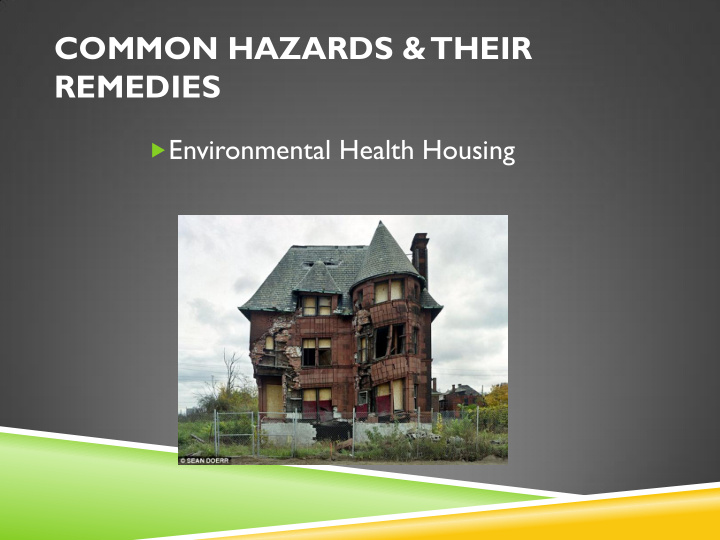



COMMON HAZARDS & THEIR REMEDIES Environmental Health Housing
WHO WE ARE. Environmental Health Housing consists of : Housing Reactive Team – Enquiries are investigated primarily relating to properties that are rented or owned. Housing Licensing Team – Enquiries and licensing relating to Houses in Multiple Occupation (HMO).
WHAT WE DO We respond to service requests and enquiries from landlords, tenants, owner occupiers and other members of the public including neighbours and other agencies such as social services, Building Control etc. We deal with an average of 1500-1900 service enquiries a year.
GENERAL COMPLAINTS HOUSING REACTIVE TEAM DEAL WITH Drainage – private drains, private pumping stations, drainage cross connections etc. Statutory Nuisance issues such as odours arising from domestic properties and water ingress by party walls, dog faeces, pigeon faeces, rodent and insect infestations Overcrowding Immigration Inspections / Accommodation Certificates Empty property nuisances / open to trespass Possible hazards at the property, for example, defective heating provision, damp and mould growth, falls and trip hazards etc.
HOUSING ACT 2004 We primarily use the Housing Act 2004 as our legislation when inspecting properties. We determine defects and identify hazards which are assessed under the Housing Health and Safety Rating System , or HHSRS There are 29 hazards that we can investigate and assess. This includes damp and mould, falls, structural collapse, excess cold, electrical safety, carbon monoxide, lighting, pests and refuse, personal hygiene sanitation, fire, noise.
COMMON HHSRS HAZARDS OR DEFECTS Damp and mould growth Lack of heating and/or hot water. Falls or trips Excess cold
CONDENSATION MOULD
CONDENSATION – LIKELY CAUSES When undertaking management visits, check: Are there clothes upon the radiators. Are tumble driers lacking proper ventilation. Can the windows be opened? i.e. are they painted shut, broken, missing keys to any locks. If mould is present would a mechanical vent or trickle vents to windows help? Use a suitable mould inhibitor to destroy and remove the mould.
CONDENSATION Is the heating system working correctly and serviced annually Does the tenant know how to use the heating system? i.e. provide instructions and leave a copy of the manual with the tenant. Are the tenants using a Calor gas heater in addition to the existing heating ? Should you wish to receive further guidance, please do not hesitate to contact this office. Copies can also be emailed as a pdf file.
EXCESS COLD
EXCESS COLD – LIKELY CAUSES Excess cold will usually score highly under the HHSRS. It is recommended that whilst undertaking your management, you check: Is there a lack of sufficient heating provision to the property? This can also potentially cause condensation issues. Is insulation installed in the property (walls / roof / draught proofing)? Are there gaps to the entrance doors? Are the seals and glazing to the windows sufficient or defective? Could double glazed units be installed to the property? If they are eligible, could the tenants be referred to NEST to potentially assist with boiler / heating system upgrades. A simple fix, does the letterbox to the property have both internal and external covers?
FALLS AND TRIPS
FALLS AND TRIPS. Falls, again, can score highly under the HHSRS. Whilst undertaking your management inspection, check if any occupants could potentially injure themselves through falls or trips at the property: Does the staircase have a full handrail with gaps more than 100mm? Is the staircase open on one side, missing any spindrels, or has horizontal guards with open gaps? Are the front and rear gardens raised and have a wall and / or steps? If so, seek to install guarding. If you decide not to install solid boards, any spacing or gaps between the guarding / spindrels must meet building regulation standards (be 900mm internally high, 1100mm externally high and have open gaps less than 100mm). Are there carpet grippers, threshold strips to the floor coverings? Is the carpet ( if installed ) fraying or loose. Are there loose or damaged floor tiles, paving tiles, low level walls.
WHAT WE DO IF WE RECEIVE AN ENQUIRY Initially we will make a visit to the property and assess for hazards. Generally, we informally write to the landlord asking for repair works to be completed within approx. 28 days. However, this will depend on the severity of the hazard identified and landlord previous compliance. We welcome correspondence from the landlord and aim to work together on timescales and any concerns raised. Revisits are then undertaken to check compliance. If the works are not completed and the landlord is not engaging with us then we do have the power to serve a legal notice. There is currently a charge of £385 for these notices.
During regular management checks at the property, check for any repair works that might be required to minimise any potential hazards or defects. e.g. signs of dampness, condensation mould growth, overcrowding , heating issues etc. A landlord has a legal right to enter their rented property to inspect it or carry out repair works, providing at least 24 hour’s notice is given, although in an emergency access may be required sooner. We advise to provide the tenants with more than 24 hours notice.
ANY QUESTIONS? Contact us For help and advice Telephone – 01633 656656 Email – env.health@newport.gov.uk or hmo@newport.gov.uk
Recommend
More recommend